Click on images to enlarge

infestation in brigalow scrub (Photo: Land Protection, QDRNW)
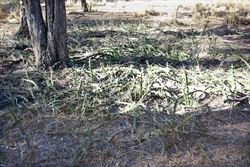
infestation in eucalypt woodland (Photo: Sheldon Navie)
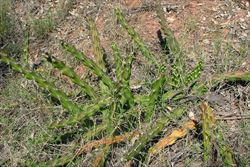
habit (Photo: Sheldon Navie)

habit in fruit (Photo: Land Protection, QDRNW)
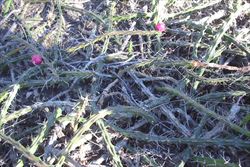
dense mat of tangled stems (Photo: Sheldon Navie)
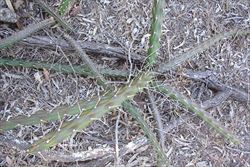
elongated stem segments (Photo: Sheldon Navie)
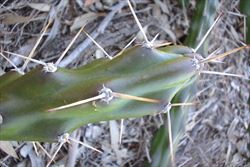
close-up of stem segment showing raised humps and clusters of spines. Each cluster has one or two larger spines and several very small spines (Photo: Sheldon Navie)

mature fruit with some spines (Photo: Sheldon Navie)

close-up of mature fruit, showing white fleshy pulp dotted with black seeds (Photo: Sheldon Navie)

damage caused by the mealy bug Hypogeococcus festerianus, an introduced biological control agent (Photo: Sheldon Navie)

the very similar Harrisia tortuosa, with less obvious raised humps and larger clusters of spines. Each cluster has a few large spines and several slightly smaller spines (Photo: Sheldon Navie)
Scientific Name
Harrisia martinii (Labour.) Britt. & Rose
Synonyms
Cereus martinii Labour.Eriocereus martinii (Labour.) Riccob.
Family
Cactaceae
Common Names
harrisia cactus, moon cactus, moonlight cactus, snake cactus
Origin
Native to southern South America (i.e. Argentina and possibly also Paraguay).
Cultivation
This species was deliberately introduced into Australia as a garden ornamental in the late 1800s. It was commonly grown in the inland areas of Queensland, particularly around mining towns. It is rarely, if ever, deliberately cultivated any more.
Naturalised Distribution
Naturalised in many parts of eastern Australia. It is most common and widespread in the inland parts of central and south-eastern Queensland, with the largest infestations in the Collinsville, Nebo, Moranbah, Dingo, Blackwater and Goondiwindi districts. It is also scattered in other parts of Queensland, with minor infestations located in the Millmerran, Greenmount, Gatton, Ipswich, Rockhampton, Rannes, Mt Morgan, Alpha and Mitchell districts. Also naturalised in the Boggabilla and Yetman areas in inland northern New South Wales.
Habitat
A weed of open woodlands and pastures that is most commonly found in semi-arid regions and drier sub-tropical and tropical habitats.
Habit
A long-lived (i.e. perennial), fleshy (i.e. succulent), plant that clambers across the ground and forms tangled mats usually 30-60 cm tall. It may also scramble or climb up over other plants to a height of 2 m.
Distinguishing Features
- a long-lived fleshy plant that clambers over the ground or scrambles over other plants.
- its stems are divided into elongated, almost cylindrical, segments.
- it does not have any obvious leaves, but has spines arranged in small groups on ridges along the stems.
- its large white or pinkish flowers (15-20 cm long) have numerous 'petals' and open at night.
- its fleshy fruit (2-6 cm across) are bright red in colour and are often covered in groups of spines.
Stems and Leaves
The stems are fleshy (i.e. succulent) and green or slightly reddish-purple in colour. These stems (25-40 mm thick) are slightly five or six angled and are split into segments, with joints (i.e. nodes) at 30-100 cm long intervals. The angles or ridges on the stems are adorned with low pyramid-shaped humps (i.e. pyramidal tubercles) that are each topped with a cluster of spines (i.e. at an areole). Each of cluster consists of one to four large central spines (10-35 mm long) and three to seven smaller appressed spines (1-6 mm long).
The leaves are reduced to inconspicuous structures at the base of the spines, and are quickly shed from the younger stem segments (i.e. they are caducous).
Flowers and Fruit
The large and showy flowers (15-20 cm long) are borne singly along the stems. They consist of many white or pinkish 'petals' (i.e. perianth segments) that are fused together into a tube at the base. The outermost of these 'petals'' (i.e. perianth segments) are smaller and usually greenish in colour. These flowers usually open at night and begin to wither by the next morning. Flowering occurs mostly during spring and early summer, but may continue through until early autumn if conditions are acceptable.
The fleshy fruit are bright red when mature and almost rounded (i.e. sub-globular) in shape. These fruit (2-6 cm across) are covered in small swellings (i.e. areoles), on which groups of 3-5 spines are sometimes borne. They split on one side when they are ripe to reveal a white pulp that is dotted with 400-1000 small black seeds.
Reproduction and Dispersal
Harrisia cactus (Harrisia martinii) reproduces by seed and vegetatively via its fleshy (i.e. succulent) stem segments, which readily take root when they come into contact with soil.
The seeds are spread by birds and other animals (e.g. foxes, emus, pigs, goannas and ants) that eat the fruit. Stem segments may be dispersed by animals, vehicles and in dumped garden waste.
Environmental Impact
Harrisia cactus (Harrisia martinii) is regarded as an environmental weed in Queensland and as a potential environmental in New South Wales. It is ranked among the top 200 most invasive species in south-eastern Queensland and is listed as a priority environmental weed in one Natural Resource Management region.
This species is particularly troublesome in brigalow woodlands and rangelands in the inland regions of Queensland, but also invades eucalypt woodlands and cypress pine forests. It is shade tolerant and prefers to grow in the sheltered areas underneath trees and shrubs. Before a relatively successful biological control programme, harrisia cactus (Harrisia martinii) formed impenetrable thickets covering many hectares. It is now less aggressive, but is still considered to pose a significant threat to rangeland biodiversity in eastern Australia.
Other Impacts
The sharp spines are a hazard to humans and animals, and cause painful injury to those who accidentally walk into or otherwise touch the plant. Harrisia cactus (Harrisia martinii) spreads quickly and has the ability to eventually take over large areas of grazing country. These dense infestations choke out pastures, and the spines make the remaining pasture plants difficult for livestock to access, thereby significantly reducing carrying capacities. Infestations also interfere with other farming operations such as mustering.
Legislation
This species is declared under legislation in the following states and territories:
- New South Wales: Class 4 - a locally controlled weed. The growth and spread of this species must be controlled according to the measures specified in a management plan published by the local control authority and the plant may not be sold, propagated or knowingly distributed (throughout the entire state).
- Queensland: Class 2 - landowners must take all reasonable steps to keep land free of this species (throughout the entire state). It is also illegal to sell a declared plant or its seed in this state. This declaration also applies to all harrisia cacti (i.e. Harrisia spp.).
- Western Australia: P1 - trade, sale or movement into the state prevented, and P2 - to be eradicated (in the Port Hedland, East Pilbara, Roebourne and Ashburton local authority areas).
Management
For information on the management of this species see the following resources:
- the Biosecurity Queensland Fact Sheet on this species, which is available online at http://www.dpi.qld.gov.au.
- the North West Weeds information page on this species at http://www.northwestweeds.nsw.gov.au/harrisia.htm.
Similar Species
Two closely-related species (Harrisia pomanensis and Harrisia tortuosa), that are much less common, are easily confused with harrisia cactus (Harrisia martinii). These three species can be distinguished by the following differences:
- Harrisia martinii has stem ridges with prominent pyramid-shaped humps (i.e. pyramidal tubercules). Its relatively large spines are arranged in groups containing 1-3 larger ones (10-35 mm long) that radiate outwards and 5-7 much smaller ones (1-6 mm long) that are held closer to the stem. Its fruit have several to many small spines.
- Harrisia tortuosa has stem ridges with only slight humps. Its spines are very large and arranged in groups containing 1-3 larger ones (25-60 mm long) that radiate outwards and 6-10 slightly smaller ones (up to 20 mm long) that are held closer to the stem. Its fruit usually have a few spines.
- Harrisia pomanensis has stem ridges with only slight humps. Its relatively large spines and arranged in groups containing 1-3 larger ones (10-20 mm long) that radiate outwards and 6-8 smaller ones (up to 10 mm long) that are held closer to the stem. Unlike the other two species, its fruit have no spines.
Several other cacti, including tiger pear (Opuntia aurantiaca), sword cactus (Acanthocereus pentagonus) and moonlight cactus (Hylocereus undatus), are relatively similar. Tiger pear (Opuntia aurantiaca) can be distinguished by its almost rounded (i.e. terete) or slightly flattened stems and its yellow or lemon flowers. Sword cactus (Acanthocereus pentagonus) has strongly three- to five-angled stems with large spines (10-40 mm long), while moonlight cactus (Hylocereus undatus) has strongly three-angled stems with tiny spines (2-4 mm long). The latter two species also often climb up into the canopies of larger trees.

